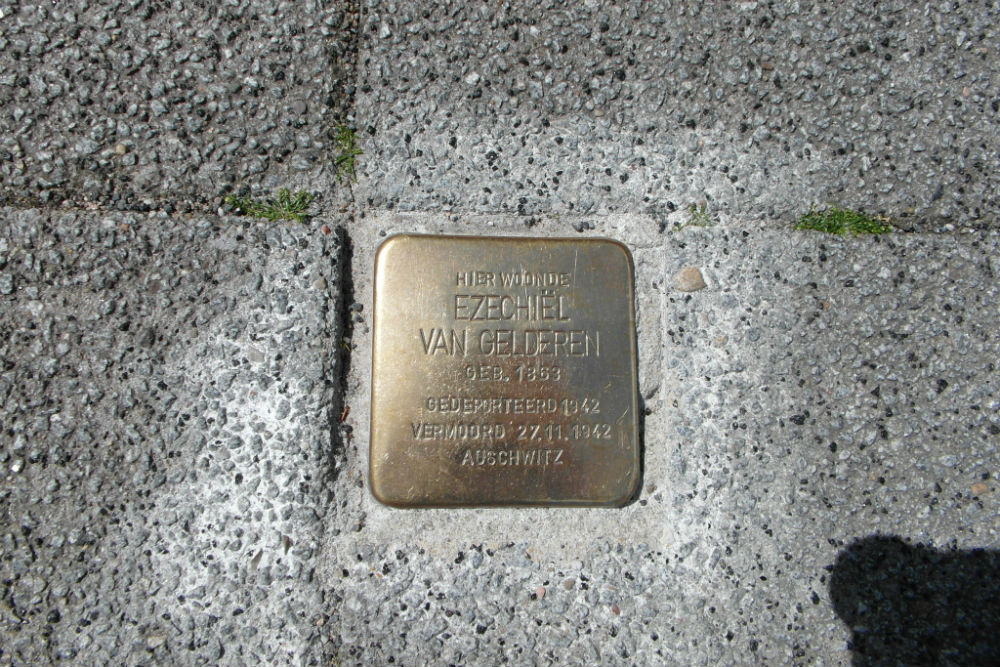Stumbling Stone Burgwal 45
This small, brass memorial plaque (Stolperstein or stumbling stone) commemorates:
* Ezechiël van Gelderen, born 1863, deported 1942, murdered 27 November 1942, Auschwitz.
Ezechiël van Gelderen’s parents were stoneware merchants, and his father was also a Jewish studies scholar. Ezechiël married Jetje Zwart. Their three sons and two daughters were all born in Kampen, from 1889 to 1905. Jetje herself died in 1917. Two years later, Ezechiël married Hester van Emden; she died in Kampen in 28 September 1941, age 71.
Ezechiël and all five of his children were murdered in Auschwitz, each on a different date: Ezechiël (27 November 1942, age 79), Maurits (26 October 1942, age 52), Rebecca (22 October 1942, age 51), Henriette (7 December 1942, age 50), Levie (28 February 1943, age 46), and Arie (01 December 1942, age 37). Of Ezechiël van Gelderen’s descendants, only one grandchild survived the Shoah.
Because of construction at the time, Ezechiël van Gelderen’s stolperstein was first placed in 2012 at the main entrance to Myosotis Engelenberg Park. In 2016, it was moved to Burgwal 45. To have placed it at the actual location where he once lived (Gast- en Proveniershuizen at Boven Nieuwstraat 46) would have left it in a less suitable place at the back of a complex of buidlings.
In the hall of the main entrance of the Ijsselheem Margaretha here at Burgwal 45, there is also a memorial plaque for Ezechiël van Gelderen.
Stolpersteine for two of Ezechiël's sons, Arie and Maurits van Gelderen, are at Hofstraat 69 in Kampen.
"Stolpersteine" is an art project for Europe by Gunter Demnig to commemorate victims of National Socialism (Nazism). Stolpersteine (stumbling stones) are small, 10x10cm brass plaques placed in the pavement in front of the last voluntary residence of (mostly Jewish) victims who were murdered by the Nazis. Each plaque is engraved with the victim’s name, date of birth, and place (mostly a concentration camp) and date of death. By doing this, Gunter Demnig gives an individual memorial to each victim. One stone, one name, one person. He cites the Talmud: "A human being is forgotten only when his or her name is forgotten."
Do you have more information about this location? Inform us!
Source
- Text: Fedor de Vries & Anne Palmer
- Photos: Joop van Dijk
- Struikelstenen in Kampen
- Joods Monument
- Yad Vashem Central Database of Shoah Victims’ Names
- Geni.com
- Stolpersteine.eu
Nearby
Museum
Point of interest
Monument
- Jewish Memorial Kampen - Kampen
- Memorials Executions - Kampen
- Memorial Stone Albert Knipmeijer - Kampen
Cemetery
- Dutch War Graves Roman Catholic Cemetery IJsselmuiden - IJsselmuiden
- Commonwealth War Graves IJsselmuiden - IJsselmuiden
- Dutch War Graves IJsselmuiden - IJsselmuiden
Remembrance Stone
- Stumbling Stones Geerstraat 25 - Kampen
- Stumbling Stone Boven Nieuwstraat 59 - Kampen
- Stumbling Stones Oudestraat 39 - Kampen





